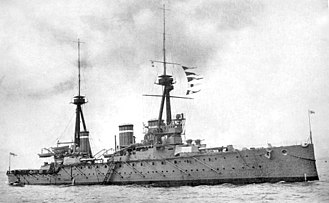An editor has nominated this article for deletion. You are welcome to participate in the deletion discussion , which will decide whether or not to retain it. |
During the first years of the 20th century, many navies constructed or planned to build battlecruisers: large capital ships with greater speed but less armor than dreadnought battleships. The first battlecruisers, the Invincible class, were championed by the British First Sea Lord John Fisher and appeared in 1908, two years after the revolutionary battleship HMS Dreadnought. [1] In the same year, Germany responded with its own battlecruiser, SMS Von der Tann. [2] Over the next decade, Britain and Germany built an additional twelve and six battlecruisers, respectively. [3] Other nations joined them: HMAS Australia entered service for the Royal Australian Navy in 1913, [4] Japan constructed four ships of the Kongō class from 1911 through 1915, [5] and in late 1912 Russia laid down the four Borodino-class battlecruisers, though they were never completed. [6] Two countries considered acquiring battlecruisers in this time, but chose not to: France looked at several battlecruiser design studies in 1913 and 1914, [7] and the United States ordered six Lexington-class battlecruisers in 1916 that were never built. [8]
Contents
The British and German battlecruisers were used extensively during World War I between 1914 and 1918, including in the Battles of Heligoland Bight and Dogger Bank, and most famously in the Battle of Jutland on 31 May and 1 June 1916, where one German and three British battlecruisers were sunk. [9] The Japanese battlecruisers did not see action during the war, as the German naval presence in the Pacific was destroyed by the British in the early months of the war. Britain and Germany attempted to build additional battlecruisers during the war—the Admiral class for the former, and the Mackensen and Ersatz Yorck classes for the latter—but changing priorities in favor of smaller warships prevented their completion. [10] At the end of the war, the German High Seas Fleet was interned and subsequently scuttled in Scapa Flow. [11]


